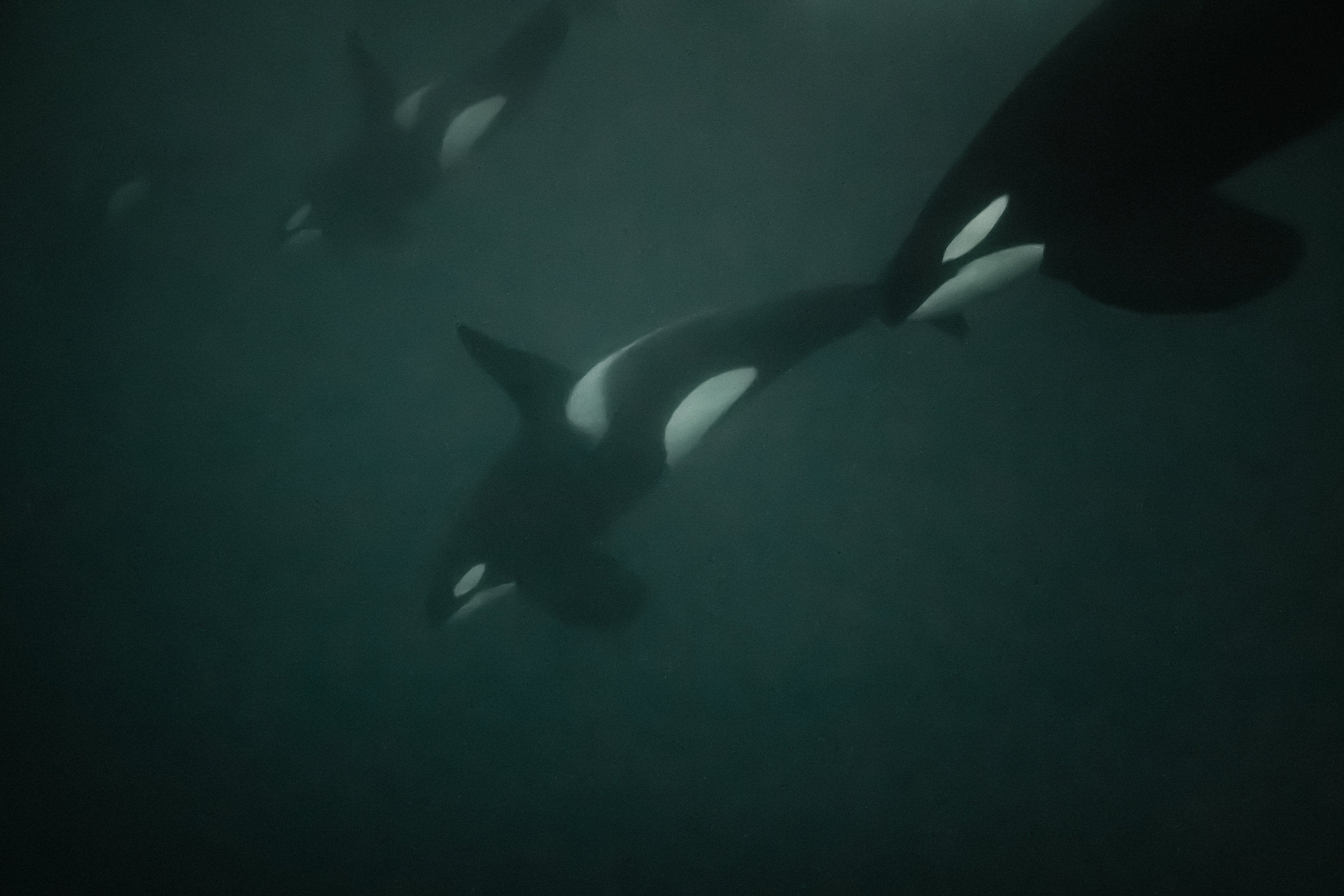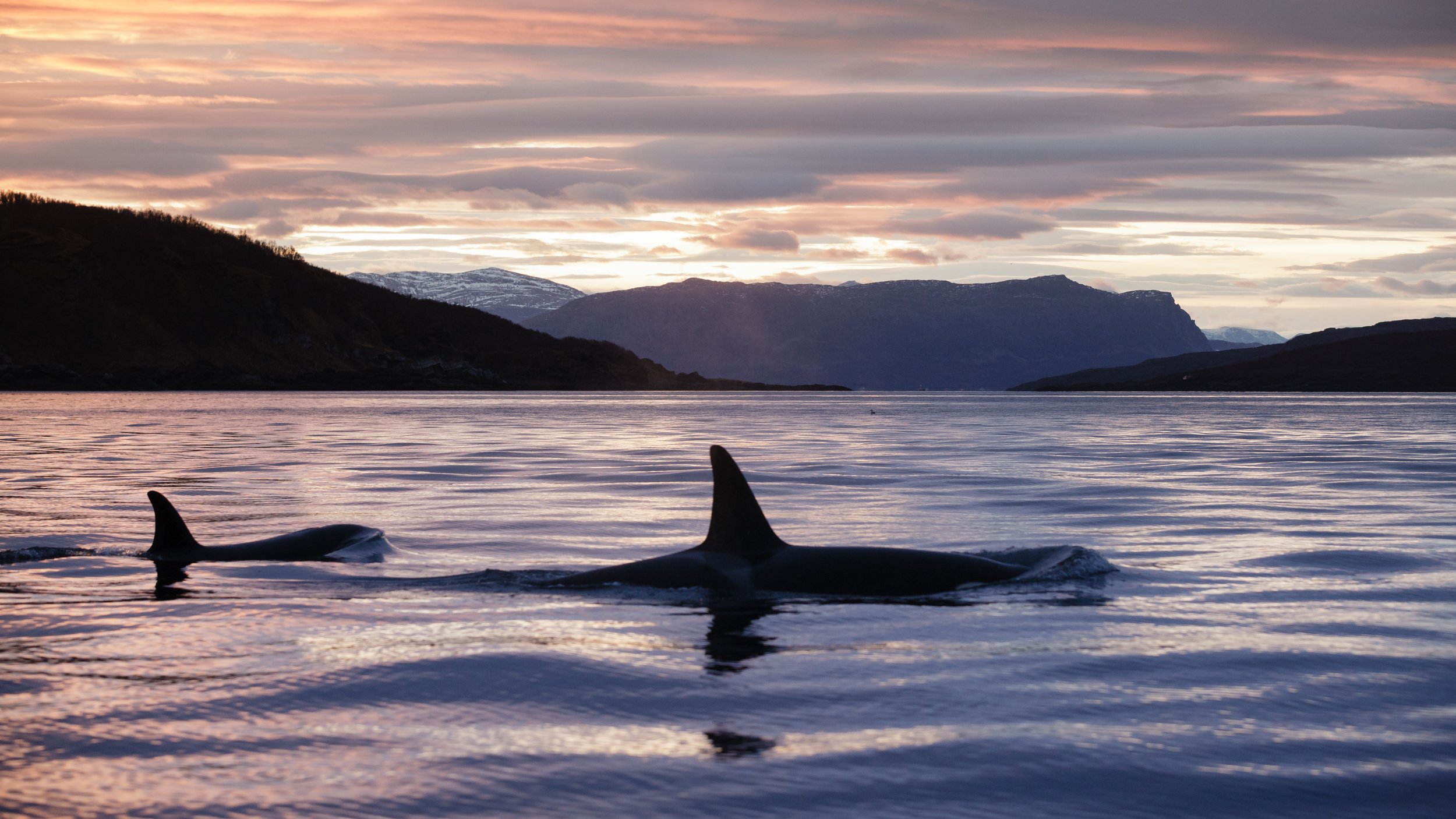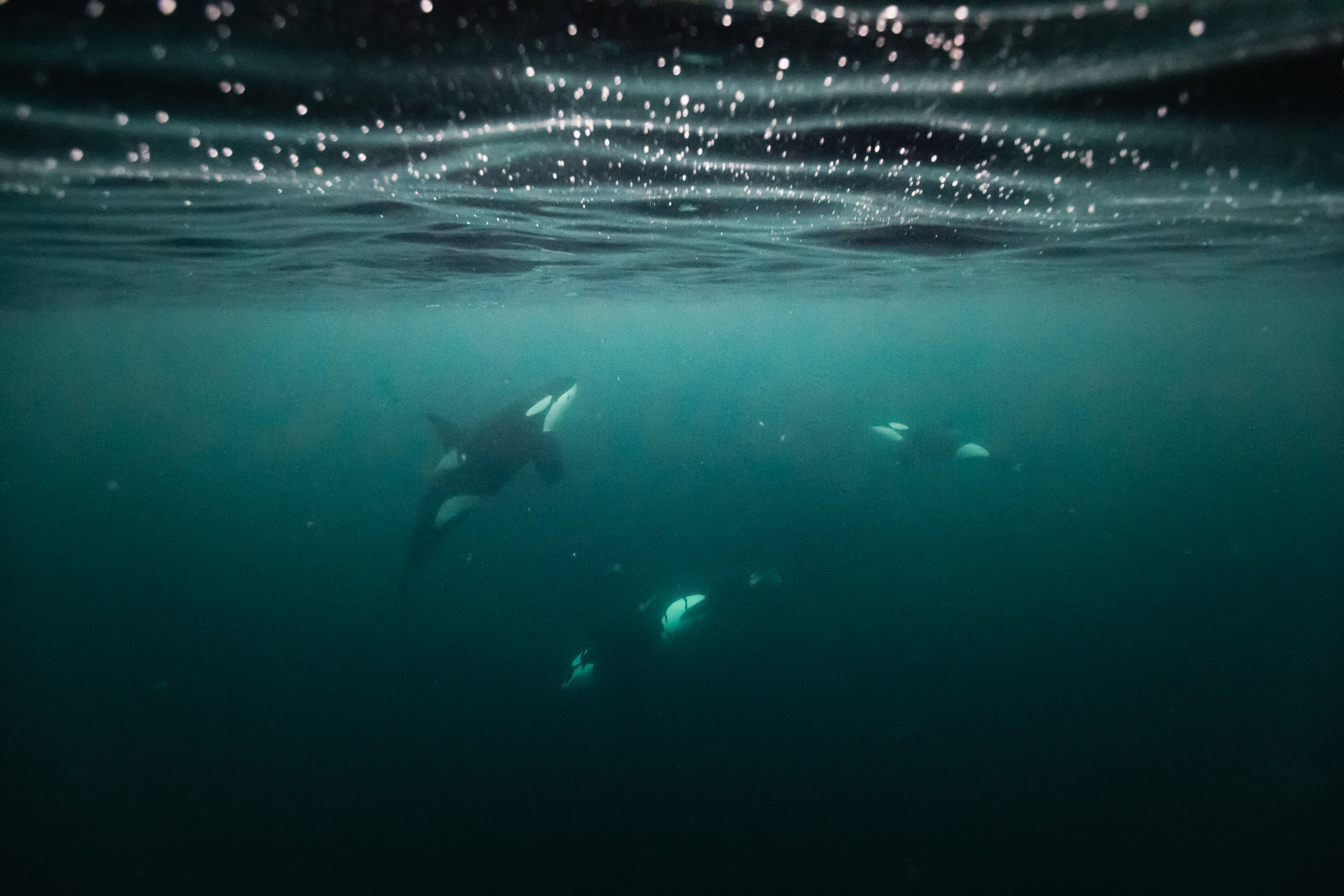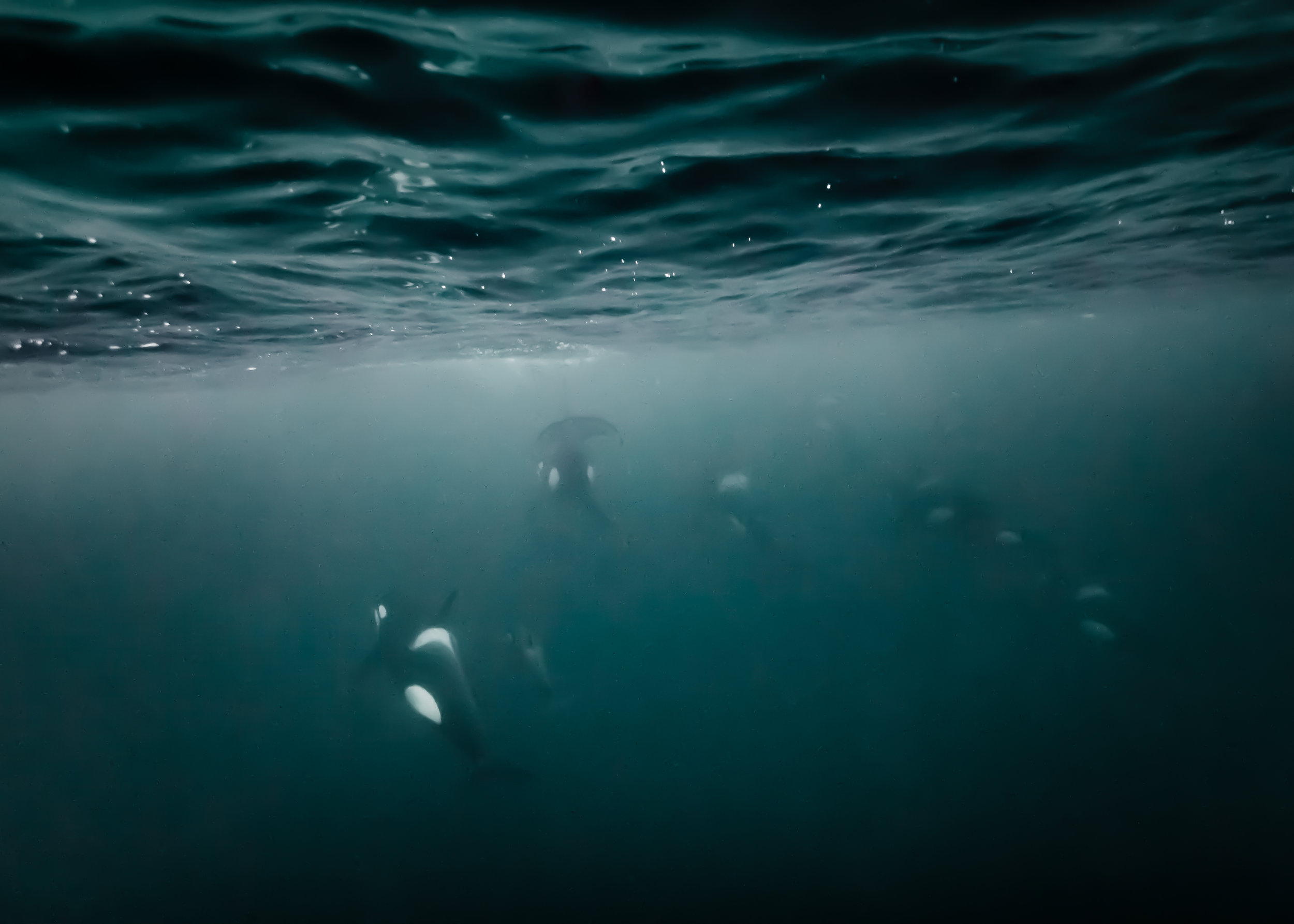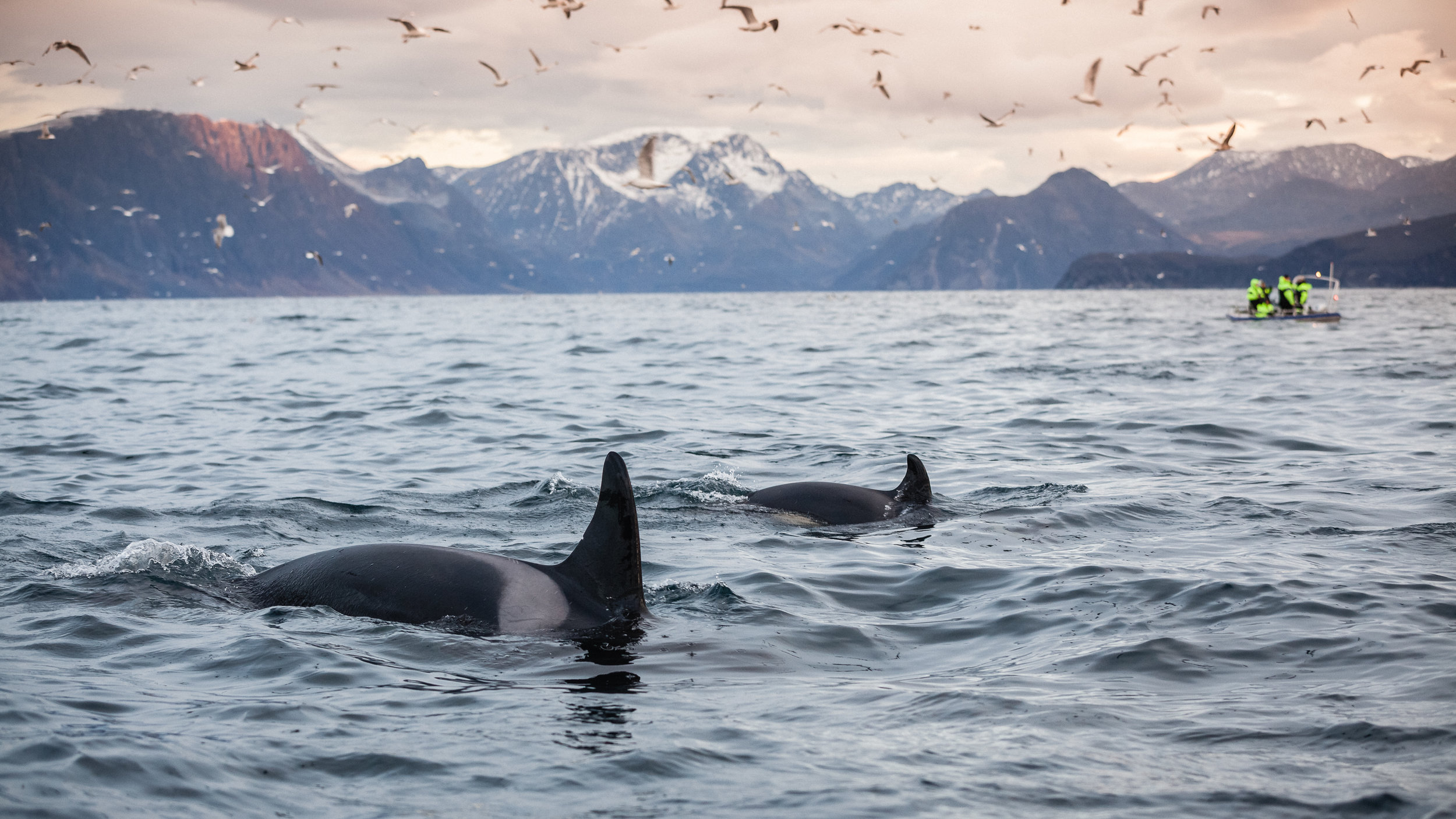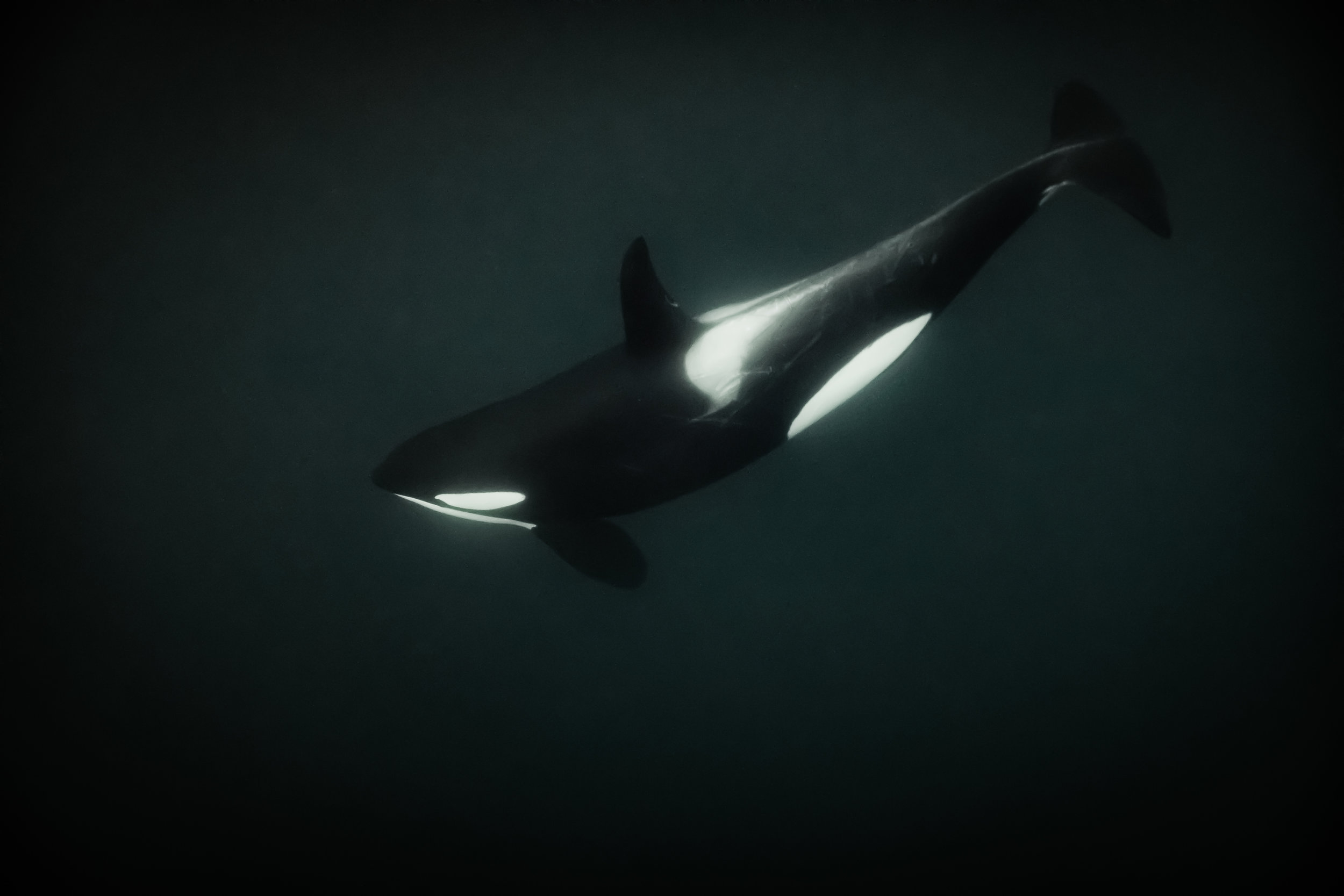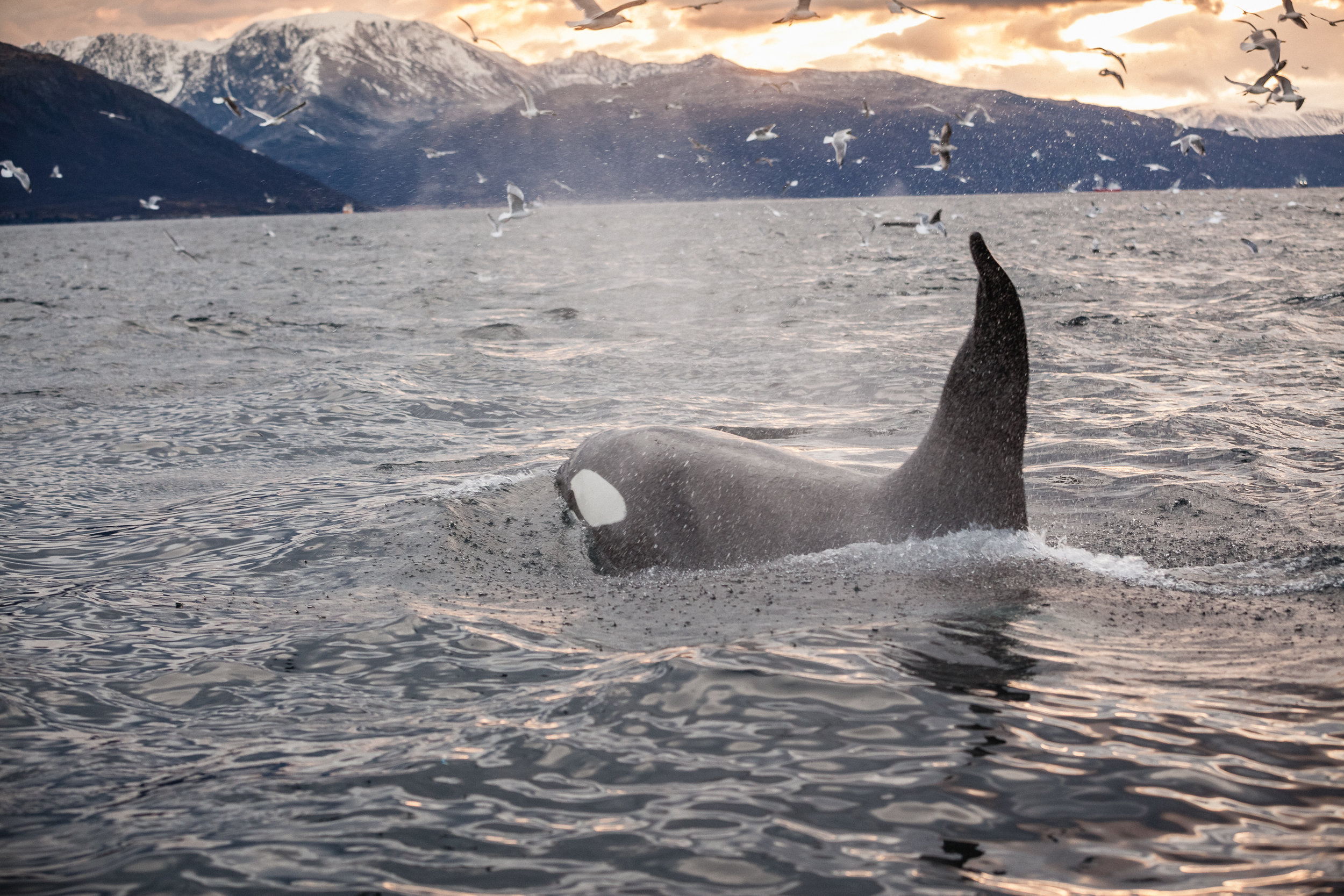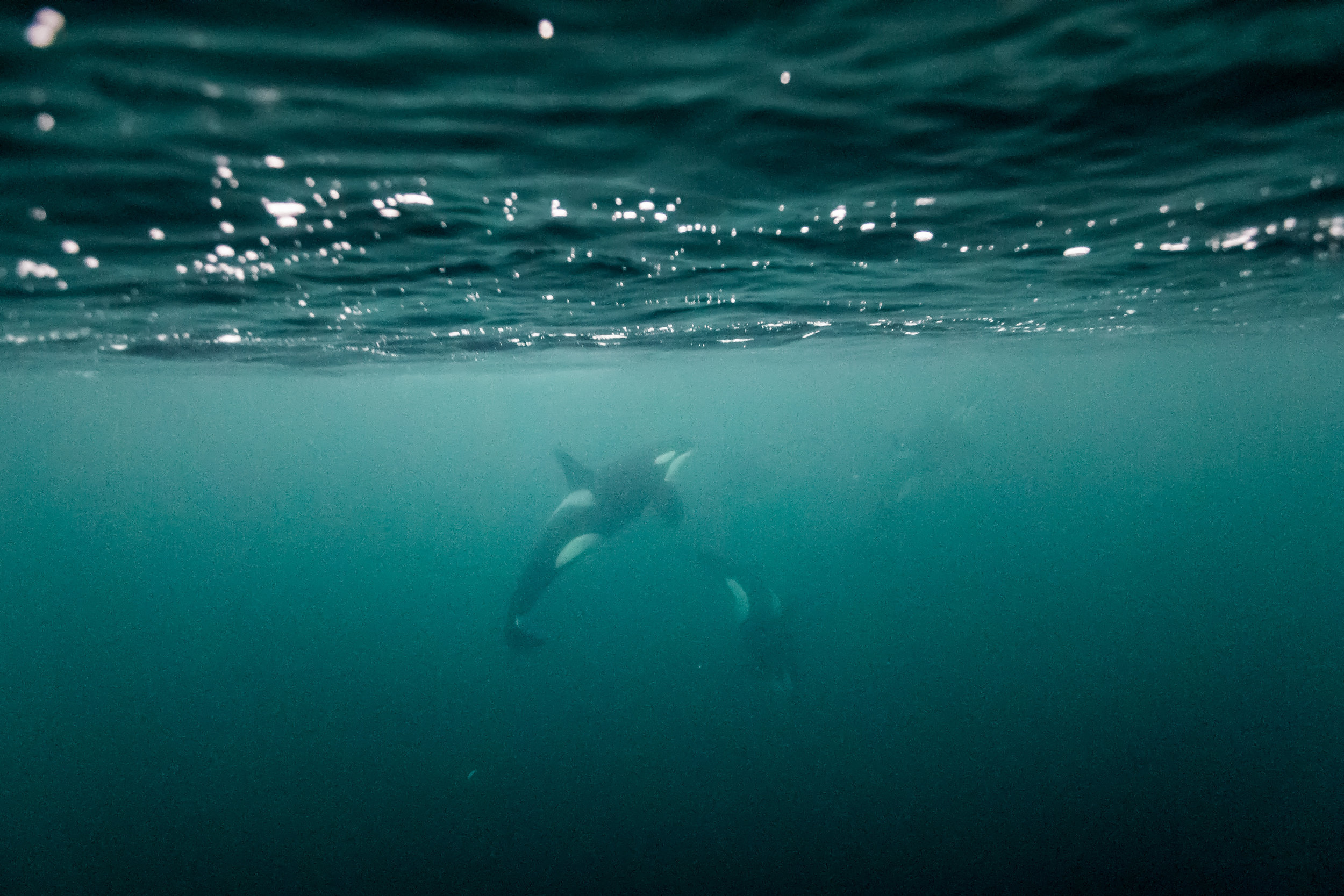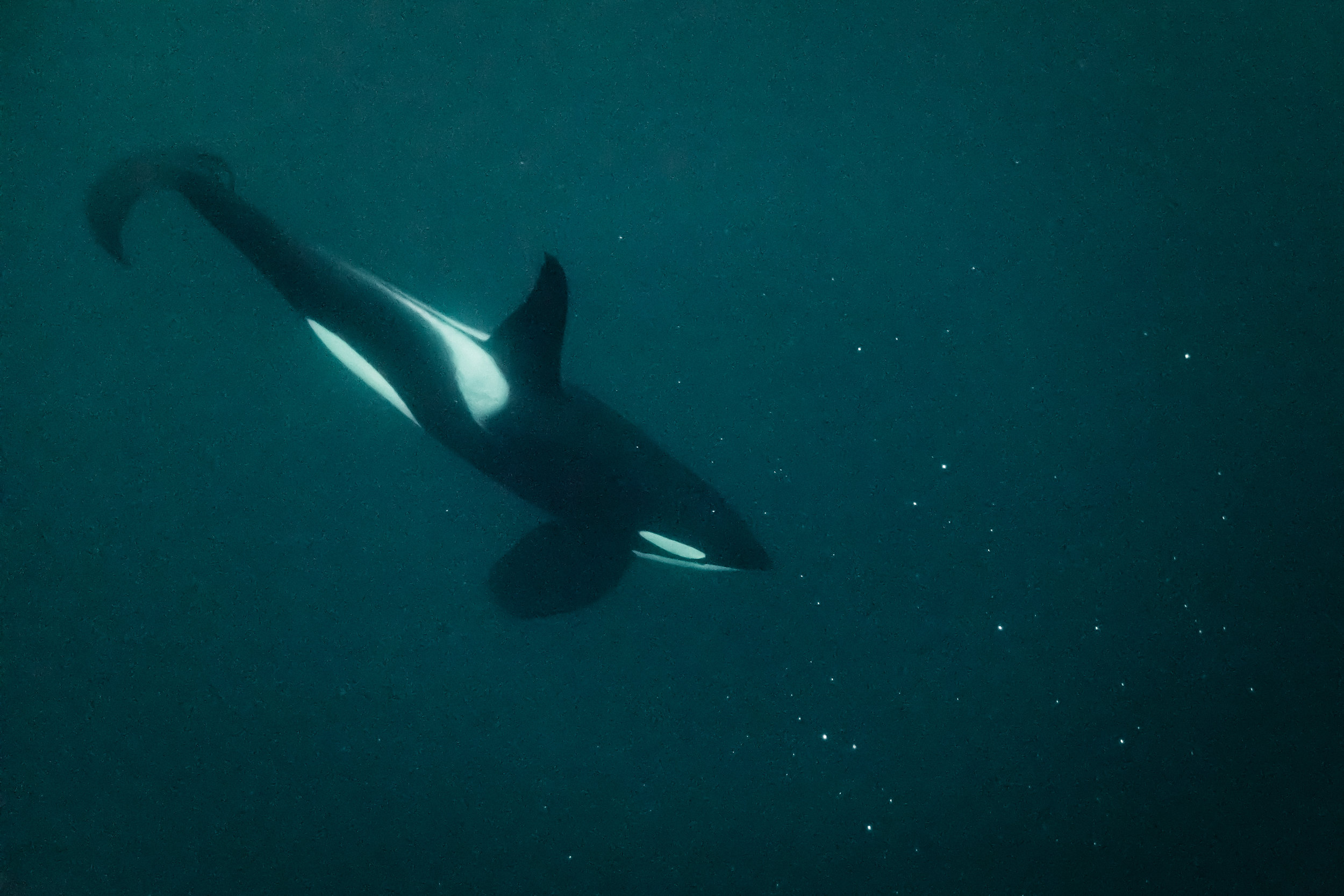The photographer in me feels I have to start with a side note about the photography. Especially the underwater photos. So here it goes… many of these images are pretty much rubbish. But these images aren’t about perfection. I learned to let that go on this trip. They are here to illustrate a story. They are images that taught me something. They are images that inspire me to do better, to keep going, to keep shooting, to keep learning, to keep creating, to keep growing, to keep discovering, to keep loving, and to keep sharing. If there’s any place on Earth that can help you let go of perfection, it’s the arctic waters of northern Norway in winter. And that’s really what this is all about anyway.
The iconic Orca dorsal fin slices through the water, catching the golden arctic light of winter
Four male Orcas dive down into the depths
A large male Orca near the surface
I sometimes dream about Orcas. I think many people do. I always wondered what it was that I found so compelling about them. Was it their beauty, their grace? Their intelligence? Their skills? I’m not even sure I can pin it down after spending 5 days in their presence. But I think I’m closer…
I think it’s all of the things I listed above and so much more. They have soul and personality. Their social skills resemble ours. They have a strong sense of family. They have obvious likes and dislikes. You can see the bonds they have with their families. And every encounter, no matter how much we worked to make it happen, you got the distinct feeling that you had nothing to do with it. The Orcas simply allowed it. Or they didn’t. You didn’t factor into it at all. You just showed up. And I’m extremely grateful for each and every second they allowed us in their presence.
A cotton candy sunrise
They say all life came from the sea. President John F. Kennedy made a speech at a sailing competition once and his words really resonated with me: “We have salt in our blood, in our sweat, in our tears. We are tied to the ocean. And when we go back to the sea, whether it is to sail or to watch it, we are going back from whence we came.” Orcas came from the sea and then they went back to it. They were once land animals, almost like wolves. Perhaps that’s where I find my deepest connection to them. I get it. I get why they might have ventured back to the sea. Even though I can’t live there, I spend as much time there as I can. Perhaps I’m a tiny bit jealous of their ability to evolve to the ocean (yes, I know it took millions of years). I struggle like a fish out of water in the ocean but they’ve adapted so perfectly it’s like they never left. It’s truly beautiful.
One of the most incredible moments is when an Orca looks you straight in the eye!
Orcas with humpbacks in the background
Here on the Pacific coast of the US and Canada we have two types of Orcas, Residents and Transients. Residents eat fish and Transients eat other marine mammals. You may have recently heard of the critically endangered Southern Resident Orcas. I believe there are only 75 left. They feed mostly on Salmon in the Pacific Northwest and salmon numbers are dropping significantly and the Orca population is starving. Moving open net fish farms (completely or mostly) out of the Salish Sea and breaching lower river damns to let the Salmon spawn is really the only way to save them.
The Norwegian Orcas are mostly fish eaters but they have been observed eating a seal or two in the summer months. They are the only population that switches between the two. Scientists believe the population is around 3,000 individuals.
Orcas are extremely intelligent so they’ve learned how to steal fish from fishing nets. This can be dangerous for them since they can either get entangled in the nets or, because they are so close to the fishing vessels, they can get hit by boats.
A pod of Orca swim full speed across the fjord to take advantage of a fishing boat
The pod was porpoising with joy as they raced across the fjord
An Orca with a fleeing herring
Normally, Orcas will locate a school of herring and corral it into a bait ball near the surface. They will take turns either hypnotizing the fish by flipping over to show their white bellies or they will tail slap them to stun them. The most amazing thing to observe is how graceful and almost gentle they are when they grab each fish, eating only one at a time.
An Orca heads straight for the bait ball
Corralling the fish towards the surface
Exposing their white undersides to the bait ball
Gracefully flicking a fish into his mouth
Orcas are extremely social and family oriented. They are matriarchal (maybe another reason I’m so drawn to them!?). Male Orcas stay with their mothers their entire lives, only venturing off to mate for a day or two before they return to their pod. Female Orcas also stay with their families until the pod gets too big, at which point the oldest daughter will break off with her offspring and start a new pod. Orcas, along with belugas, narwhals and pilot whales are the only other animals besides humans to live past their childbearing years. Typically, highly social animals benefit from non-childbearing “adult supervision.” Older females will know where and how to hunt most efficiently. They will also share up to 90% of the food they catch with their family, keeping them strong and well fed. Orcas also take care of their disabled members. They essentially swim at the pace of the slowest member and hunt for those members unable to do so. We also observed a male Orca sleeping on the surface. The rest of his pod didn’t seem too sleepy. In fact, they were hunting. As we watched them we noticed that each member of the pod would take turns going back to check on the sleepy male before returning to hunting. More Orcas came to check on him when the boats started swarming around him. It was an incredible behavior to observe. You could feel the love and the teamwork.
Probably my closest encounter with this sassy female Orca
Drive by!
Bye Orca pod!
Orcas are very auditory animals. They use echolocation to locate prey and they communicate constantly via clicks and squeals. It’s one of the coolest things to hear underwater. Each population of Orca has their own unique languages. They are very sensitive to sound and responded to every little squeal I uttered. They love music, too.
On the flip side, they are very sensitive to noise pollution and boat traffic. At times we would observe a pod being followed by boats, showing sings of frustration. Males will show the frustration of the pod by slapping their tails on the surface. They’d also disappear for minutes at a time and pop up in another direction, trying to avoid the boats. So while some pods were friendly and curious, other pods were standoffish or just in a “leave me alone” kind of mood. Much like humans!
Always swimming away…
A mama and her baby
Babies! Oh man, they’re cute. They are also much more curious of humans than their parents. We observed one in his/her mom’s slip stream and when he/she saw us he/she flipped on his/her back and swam upside down the whole way past us. Cheeky little one! You could clearly tell each Orca had their own unique personality and mood. Some were stand-offish. Some were playful. Some were curious. Some were all business. And some were the obvious protectors.
Sadly, only 50% of Orca babies survive. Being apex predators, the Orca consume a lot of toxins from everything lower down on the food chain. Many of these calves cannot survive their mother’s toxic milk. Keeping our oceans clear of plastics and chemicals can help alleviate this problem. As we learned in Finding Nemo, all drains lead to the sea. Please be conscious of what you throw down your drain or throw on the sidewalk that can be swept into storm drains and washed out to sea.
This young Orca was interested in my squeals and swam by me three times!
Some Orcas are cautious, like this one, swimming close enough to get a look but not too close to be in danger (or good photographing range!)
Beautiful saddle patch
Time to hold onto your socks. Here’s where it’s about to get a little preachy. I can’t help it. Some things just have to be said. But along with that, please understand that I try to leave all judgement on the table. I’m not out to blame anyone for anything. I’m not asking for perfection, either. I’m simply pointing a few things out to get you to think about your actions. Change will come, but only if we are aware of the problem. So here it goes…
You can not, I repeat, CAN NOT spend time in the wild with these animals and not look at photos of captive Orcas and want to cry and throw up at the same time (or at least I can’t). Of all of the encounters we had, we only saw the Orcas and the bottom of the ocean once. (Picture below). Imagine swimming in a wide open ocean with your closest family and then you’re put into the equivalent of solitary confinement at Alcatraz. That’s essentially what these tanks are for Orcas. Then take a look at the below picture with the ocean bottom and then take a look at the concrete bottoms of a tank at SeaWorld. Orcas have only killed humans in captivity. There is no recorded death of a human by an Orca in the wild. Many scientists believe the deaths were mental breakdowns. Ok, I think you all see where I’m going here…
Slightly out of focus but you can see the bottom!
But, like I said, perfection is not the goal here. I’ll admit it, I’ve been to SeaWorld when I was a kid. Even more recently in 2010 my husband and I did a swim with dolphins in Mexico at a seaside dolphin “sanctuary.” It was included in our resort package. The sanctuary was enclosed and concrete. I have to admit, even though at the time I wasn’t totally against the practice, the whole thing made me so upset I told my husband I never wanted to do it again. Of course, I’m sure it didn’t help that we had encountered dolphins in the wild while scuba diving just the day before. Afterward we went to swim with sting rays in a “sanctuary.” This time it was a open pen in the ocean. Fish swam in and out. The bottom was the actual ocean floor. Many of the rays were recovering from injuries. I breathed so much better there and actually enjoyed myself. At the time I didn’t know why I felt such a huge difference. Now it’s obvious. At the very least, we need to move our captive cetaceans to open pen sanctuaries. So please, don’t support these marine parks and aquariums that house cetaceans if you can. Support local whale watching companies and see them in the wild or, if you can afford it, find an operator that will let you snorkel with them. The experience is unbelievably better for both you and the animals. There’s nothing like seeing an animal in the wild!
And on that note, I’ll stop babbling and let you enjoy some photos of just that!
Some males don’t have perfectly straight dorsal fins. Some are even flopped over (no, it’s not just something that happens in captivity, but it’s rare in the wild)
Exhale…
These abnormalities in the dorsal fin make identification of these individuals much easier!
I love the sound of an Orca exhale!
Wild encounters with Orca are AMAZING!
Had to include a few pictures of the most beautiful sunrise I think I’ve ever seen…
It was our last day on the water and what a send off!
Dun, un. Dun, un. Here comes the Orca!
The drive by on video! What a cute little baby!
That’s a wrap, folks! Thanks for following along. Please feel free to share or comment below if you have any questions. Also, if you’re interested in some more info about Orcas (and Southern Residents in particular) check out the Ted Ed video below.
Thanks you lovely people!
Carra


